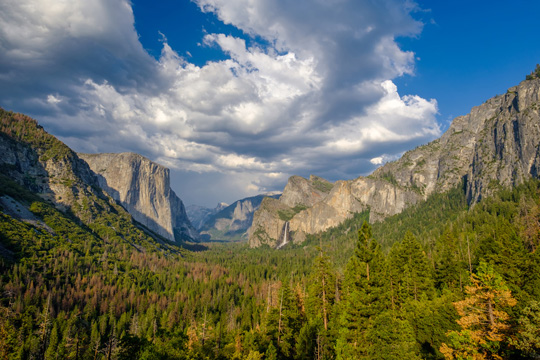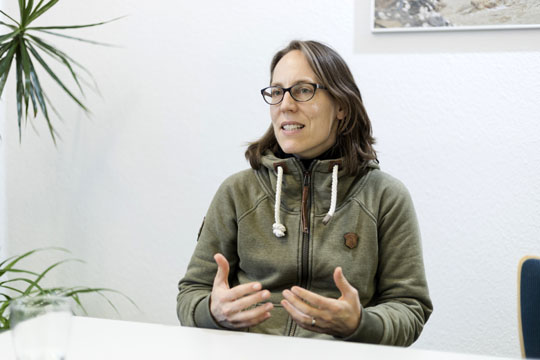Under construction
Freiburg, Apr 03, 2018
Prof. Dr. Annika Mattissek and her team in January 2018 made the topics "Matter, Materials, Methods" the orientation of the conference "New Human Geography," which was held at the University of Freiburg. Nicolas Scherger asked the geographer how she perceived the changes taking place within her discipline.
 What are the conceptions of nature that form the basis for nature conservation policies? American national parks like Yosemite were set up in a way that envisaged pristine natural surroundings, untouched by humans. By contrast in Germany, natural surroundings shaped by human hands are also deemed worthy of protection.
What are the conceptions of nature that form the basis for nature conservation policies? American national parks like Yosemite were set up in a way that envisaged pristine natural surroundings, untouched by humans. By contrast in Germany, natural surroundings shaped by human hands are also deemed worthy of protection.
Photo: haveseen/Fotolia
Frau Mattissek, why is a spatial science addressing the significance of matter and materials at all?
Annika Mattissek: Since the millennium, geography has increasingly taken on constructivist ideas. These theories and approaches examine how speech and media are produced in reality, how norms, values and expectations are shaped in relation to space, and how spatial images, stereotypes or conceptions of nature define our actions. "New human geography" has addressed this in depth. Against this backdrop, a growing number of voices are saying that constructions of meaning are important, but they do not cover everything. As a result, material factors must also be taken into consideration.
 The boundaries with other disciplines are no longer as clear as they used to be earlier, says Annika Mattissek.
The boundaries with other disciplines are no longer as clear as they used to be earlier, says Annika Mattissek.
Photo: Jürgen Gocke
What precisely are these material factors?
They include biophysical nature as well the environments shaped by humans, meaning buildings, streets and so on. It's everything that can be considered materiality, in the sense that it shapes human behavior.
So the aim is to make a comparison to see how much constructed space corresponds to the givens in reality?
Reality is really one of those things. Let's take, nature conservation, for example. There, the question is, what are the conceptions of nature that form the basis for nature conservation policies. In an American context, the separation between nature and culture is important, so the national parks were set up in a way that envisaged pristine natural surroundings, untouched by humans. By contrast in Germany, natural surroundings that have been shaped by human hands are also deemed worthy of protection, such as the forests that are tended by forestry businesses. All-in-all, it's about the question of how reality emerges from the interaction of ideas, norms and values on the one hand, and biophysical influences on the other.
Which example from your research illustrates particularly well that material factors are again playing a more important role?
In a project with my doctoral candidate Robert John, we are investigating the processes by which sand in Cambodia is valorized and marketed. The mechanisms for extracting and marketing a resource such as sand – which can be found in large areas on the earth's surface and has a high weight and volume – are very different than they are for a resource such as diamonds, which are small, valuable and found in a few places underground. The materiality of what is mined and marketed has a major impact on the resulting opportunities and limits for trade as well as the environmental degradation and social conflicts related to them. Water courses and coasts are damaged by extraction of sand, for example, that leads to destruction of fish stocks, among other things, and this has societal consequences.
 Climate change, mobility, the return of the wolf: "New human geography" looks at the intersection between the environment and societal development.
Climate change, mobility, the return of the wolf: "New human geography" looks at the intersection between the environment and societal development.
Photos: piyaset/Fotolia, Jürgen Gocke, hkuchera/Fotolia
What are the new subject areas coming into existence as the discipline changes?
"New human geography" looks at the intersection between the environment and societal development. During our conference, among the issues we examined were climate change, environmental degradation, overfishing and the return of the wolf. It's also about the question of how material infrastructure shapes societal change – so with respect to the energy transition, digitalization or mobility. Beyond that, there's the influence of social media on the processes of political geography and much more.
Doesn't that lead to a blurring of the boundaries with other disciplines?
The boundaries as a whole are no longer as clear as they used to be earlier. All the same, there is a relation to spatial concepts in all these geographic works, yet it's simply often a matter of built-up space. One of my colleagues, Tobias Schopper, is investigating the question, for example, of how the concepts of space that new, ultra-right movements are spreading on the Internet contribute to the inclusion or exclusion of migrant movements.
What inspiration have you received from the conference?
Our keynote speaker, Noel Castree, raised this question: What is the role of human geography in the present day? In my opinion, its value lies in the fact that it considers space and materiality more reflectively than the other social sciences. In many disciplines there's been a tendency towards the subject of space, but not the decades-long, critical examination of spatial concepts and environmentally-deterministic ideas, according to which the biophysical state of a region predestines its socio-cultural development. It's important to incorporate the material environment into social-scientific analyses, without falling into trite causalities and instead rather observing the interplay of natural and societal factors.
Isn't environmental determinism a prejudice that the other disciplines have against geography?
Not really. It's more that most don't really have any idea what geographers do. My feeling is that geography's image is really a quite friendly, but in many respects it's too undifferentiated – and much more a picture of the city-countryside-river vision of elementary school geography.
Could the image be sharpened by geography having an increased societal influence?
Certainly. In recent years there have been repeated, effective publicity efforts to bring geography more into view, for example the International Geographical Union proclaimed 2016 as the "International Year of Global Understanding." And more and more geographers are members of policy advisory bodies, such as the "German Advisory Council on Global Change" or are on radio or television broadcasts. Locally, the city of Freiburg held the "Freiburger Umweltgespräche" and the Faculty of Environment and Natural Resources was there, and geography is involved in that. I hope that more activities of this kind are held.
Conference program "New Human Geography 15" with abstracts (in German with some English entries)

